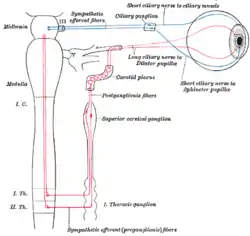| Ciliospinal center | |
|---|---|
 Sympathetic connections of the ciliary and superior cervical ganglia. (Ciliospinal center not labeled, but region is visible below superior cervical ganglion. Pathway in blue actually represents parasympathetic pathway) | |
| Details | |
| Identifiers | |
| Latin | centrum ciliospinale |
| Anatomical terminology | |
The ciliospinal center (also known as Budge's center[1]) is a cluster of pre-ganglionic sympathetic neuron cell bodies located in the intermediolateral cell column of the spinal cord at the (C8) T1-T2 spinal levels.[2]
It receives afferents from (the posterior part of) the hypothalamus via the (ipsilateral) hypothalamospinal tract which synapse with the center's pre-ganglionic sympathetic neurons. The efferent, pre-ganglionic axons then leave the spinal cord to enter and ascend in the sympathetic trunk to reach the superior cervical ganglion (SCG) where they synapse with post-ganglionic sympathetic neurons. The post-ganglionic neurons of the SCG then join the internal carotid nerve plexus of the internal carotid artery, accompanying first this artery and subsequently its branches to reach the orbit. In the orbit, they join the long ciliary nerves and short ciliary nerves to reach and innervate the dilator pupillae muscle to mediate pupillary dilatation as part of the pupillary reflex.[2]
History
It is associated with a reflex identified by Augustus Volney Waller[3] and Ludwig Julius Budge in 1852.[4]
See also
References
- ↑ "ciliospinal centre from Online Medical Dictionary". Retrieved 2007-06-05.
- 1 2 Patestas, Maria A.; Gartner, Leslie P. (2016). A Textbook of Neuroanatomy (2nd ed.). Hoboken, New Jersey: Wiley-Blackwell. p. 367. ISBN 978-1-118-67746-9.
- ↑ Jay, Venita (2002). "A portrait in history: Augustus Volney Waller Archives of Pathology & Laboratory Medicine - Find Articles". Archives of Pathology & Laboratory Medicine. Retrieved 2007-06-05.
- ↑ Ikeda H, Aruga T, Hayashi M, Miyake Y, Sugimoto K, Mastumoto K (1999). "Two cases in which the presence of ciliospinal response led to indecisiveness in the evaluation of brain death". No to Shinkei (in Japanese). 51 (2): 161–6. PMID 10198906.